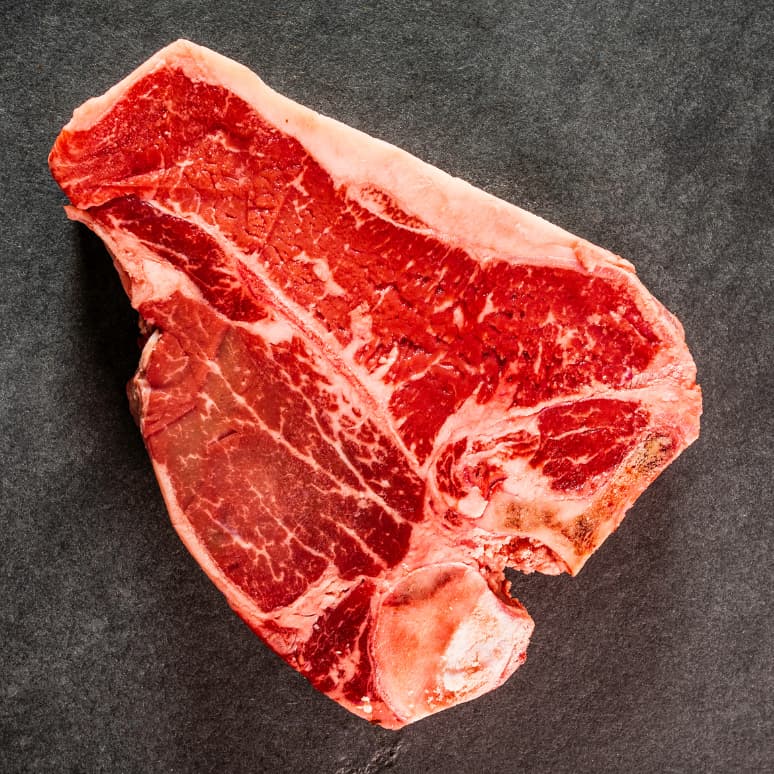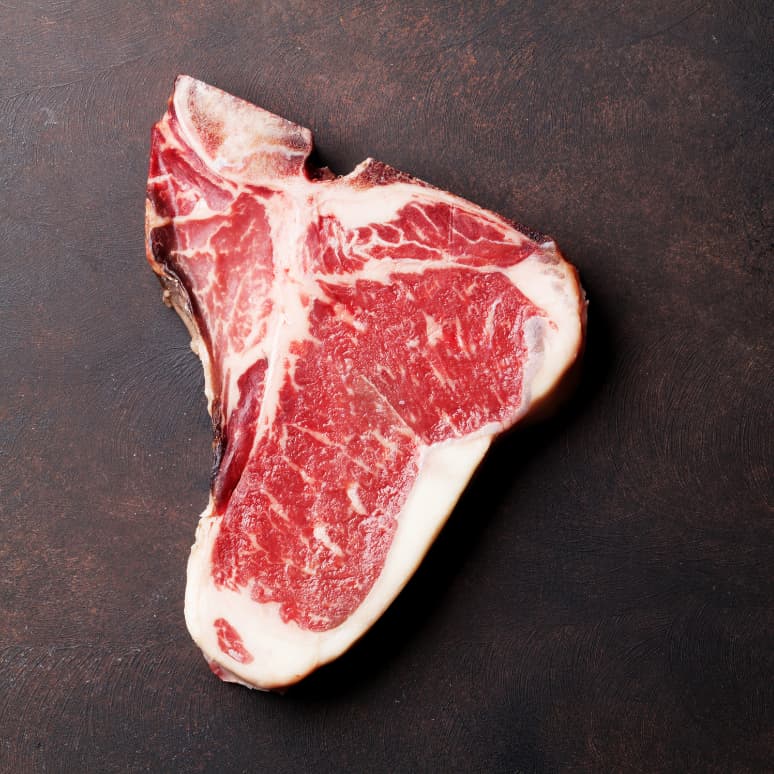When it comes to premium cuts of beef, the porterhouse and T-bone steaks often steal the spotlight. These two cuts, both originating from the short loin area of cattle, share a similar appearance with their distinctive T-shaped bone housing both the New York strip and the tenderloin filet. However, discerning steak connoisseurs recognize that beneath their exterior similarities lie significant differences. Let’s embark on a culinary journey to uncover the nuances of porterhouse vs. T-bone steaks, exploring their unique characteristics, nutritional attributes, cooking techniques, and more.
The Anatomy of Porterhouse and T-Bone Steaks
To truly appreciate the disparity between porterhouse vs T-bone steaks, it’s essential to delve into the anatomy of these cuts. Both are extracted from the short loin, renowned for its tender, succulent meat. The T-shaped bone in these steaks separates two distinct portions: the New York strip and the tenderloin filet. These segments boast contrasting textures and flavors, offering a harmonious blend of richness and tenderness. While each portion can stand alone as a delectable steak, it’s the combination of both on the bone that defines a porterhouse or T-bone.
Nutritional Value of Porterhouse Steak
Beyond their culinary appeal, porterhouse steaks are a nutritional powerhouse, brimming with essential nutrients. A typical serving size of porterhouse delivers around 200-250 calories, making it a satisfying option for protein enthusiasts. Moreover, porterhouse steak is a stellar source of iron, phosphorus, riboflavin, zinc, and Vitamin B6, supporting overall health and vitality. However, mindful consumption is key, as porterhouse can be high in saturated fat. Opting for leaner cuts and trimming excess fat before cooking ensures a balanced dietary intake.
Size Disparities
The primary distinguishing factor between porterhouse and T-bone steaks lies in their respective sizes, particularly the dimensions of the tenderloin filet. Porterhouses reign supreme with their generous filet portions, often exceeding 1.25 inches in thickness. In contrast, T-bones feature a smaller filet, typically ranging from 0.25 to 1.25 inches thick. This disparity in size significantly impacts the overall eating experience, influencing factors such as tenderness, juiciness, and flavor concentration.
Porterhouses

Porterhouse steaks epitomize indulgence with their substantial filet dimensions, making them a coveted choice among steak aficionados. According to stringent USDA standards, a T-bone steak can ascend to porterhouse status if its filet measures at least 1.25 inches thick. Positioned at the rear of the short loin, where the tenderloin is most robust, porterhouses exude extravagance, often weighing in at 24 ounces or more. These hefty cuts are quintessential centerpieces for memorable dining occasions, symbolizing culinary opulence and epicurean delight.
T-Bones

While both porterhouse and T-bone steaks share commonalities in their composition, the nuances lie in the size and thickness of the tenderloin filet. If a T-bone’s filet falls short of the 1.25-inch mark, it retains its designation as a T-bone steak. This distinction underscores the meticulous standards governing steak classification, ensuring transparency and accuracy in the marketplace. Thus, while a T-bone may evoke echoes of porterhouse grandeur, its filet dimensions ultimately dictate its culinary identity.
Price Difference
The disparity in filet size reverberates in the pricing of porterhouse and T-bone steaks, with porterhouses commanding a premium due to their larger filet proportions. However, price differentials may fluctuate based on various factors, including grading, marbling, and market demand. USDA Prime-grade cuts, revered for their superior quality and marbling, often fetch top dollar irrespective of steak type. Ultimately, the investment in either porterhouse or T-bone steak promises a gastronomic experience beyond compare, transcending mere sustenance to embody culinary excellence.
Cooking Porterhouse vs T Bone
Unlocking the full potential of porterhouse and T-bone steaks hinges on mastering the art of cooking. While both cuts lend themselves to a myriad of culinary techniques, slight adjustments in cooking times may be necessary due to filet size discrepancies. Whether searing in a cast-iron skillet or grilling over an open flame, seasoning generously with salt and pepper enhances the natural flavors of these premium cuts. Moreover, employing a meat thermometer ensures precision cooking, allowing you to achieve the desired level of doneness with confidence and finesse.
When Is My Porterhouse Steak Done Cooking?
Determining the ideal cooking duration for porterhouse steaks requires precision and attentiveness to internal temperatures. Referencing a comprehensive steak temperature guide, aim for the desired doneness level based on personal preferences. Upon reaching the target temperature, allow the steak to rest before slicing, enabling the juices to redistribute for optimal tenderness and flavor retention. Whether savoring a succulent medium-rare or indulging in a perfectly seared medium, porterhouse steak promises a culinary journey replete with savory delights.
Storing Porterhouse Steak
Preserving the freshness and flavor integrity of porterhouse steak necessitates proper storage techniques. Refrigerate fresh cuts promptly, ensuring they remain in prime condition for up to two days. Alternatively, freeze surplus portions in airtight freezer bags, minimizing exposure to air and preventing freezer burn. When thawing frozen steaks, employ a gradual thawing process in the refrigerator to preserve texture and juiciness. By adhering to recommended storage practices, you can savor the exquisite taste of porterhouse steak whenever culinary cravings strike.
Choosing Between Porterhouse and T-Bone Steaks
Navigating the selection process between porterhouse and T-bone steaks requires a discerning eye and a nuanced understanding of steak characteristics. Pay meticulous attention to filet thickness and USDA grading when perusing the meat counter, ensuring optimal quality and value. Additionally, leverage labeling cues such as Institutional Meat Purchase Specifications (IMPS) numbers to decipher steak types accurately, empowering informed decision-making and culinary satisfaction.
Alternatives to Porterhouse Steak
Exploring alternatives to porterhouse steak offers a delightful array of culinary possibilities, catering to diverse tastes and preferences. Consider opting for T-bone steaks, which offer comparable flavor profiles with slightly smaller filet dimensions and a lower price point. Alternatively, indulge in the unparalleled tenderness of filet mignon or relish the robust flavor of strip steaks. Each alternative presents a unique culinary experience, enriching your gastronomic journey with tantalizing textures and delectable flavors.
Conclusion
In essence, the distinction between porterhouse and T-bone steaks transcends mere semantics, embodying a rich tapestry of flavors, textures, and culinary traditions. By unraveling the intricacies of these esteemed cuts, steak enthusiasts can embark on a gastronomic odyssey marked by discovery and indulgence. Whether relishing the opulence of a porterhouse or savoring the timeless appeal of a T-bone, each bite serves as a testament to the unparalleled artistry of steak craftsmanship, uniting epicureans in a shared appreciation for culinary excellence and gastronomic delight.


